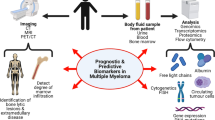Summary
Serum β2- microglobulin, serum thymidine kinase, and commonly used prognostic parameters were investigated for their prognostic value in a well-defined group of patients with multiple myeloma (n = 207). Multivariate analysis showed hemoglobin to be the parameter of strongest prognostic value. Only albumin, serum β2-microglobulin and serum thymidine kinase added further prognostic information. When tested for efficiency in recognizing patients with poor (average survival time < 1 year) and good (average survival time > 5 years) prognosis, serum β2-microglobulin was best (80%), followed by total urinary protein (78%), hemoglobin (76%), and albumin (75%).
Similar content being viewed by others
References
Adler R, McAuslan BR (1974) Expression of thymidine kinase variants is a function of the replicative state of cells. Cell 2:113–117
Alexanien RA, Balcerzak S, Bonnet JD, Gehan EA, Haut A, Hewlett JS, Monto RW (1975) Prognostic factors in muliple myeloma. Cancer 36:1192–1201
Bard R, Frisch B, Diem H, Mündel M, Fateh-Moghadam A (1989) A bone marrow histology and serum beta-2-microglobulin in multiple myeloma: a new prognostic strategy. Eur J Haematol 43:88–98
Bataille R, Durie BGM, Grenner J, San J (1986) Prognostic factors and staging in multiple myeloma: a reappraisal. J. Clin Oncol 4:80–87
Bataille R, Grenier J, Sany J (1987) Unexpected normal serum beta-2-microglobulin levels in multiple myeloma. Anticancer Res 7:513–516
Bataille R, Boccadoro M, Klein B, Durie B, Pileri A (1992) C-reactive protein and beta-2-microglobulin produce a simple and powerful myeloma staging system. Blood 80:733–737
Bergard I, Bearn AG (1968) Isolation and properties of a low molecular weight b2-globulin occuring in human biological fluids. J of Biol Chem 243:4095–4103
Dacie J (Chairmen) and all other members of the working party (1980) Prognostic features in the third MRC myelomatosis trial. Br J Cancer 42:831
Diem H, Fateh-Moghadam A, Nagel D, Lamerz R (1991) Serum beta-2-microglobulin and thymidine kinase in multiple myeloma: comparison with commonly applied prognostic factors. In: Klapdor R (ed) Tumor associated antigens, oncogenes, receptors, cytokines in tumor diagnosis and therapy at the beginning of the nineties. Zuckschwerdt, Munich, pp 181–184
Durie BGM, Salmon SE (1975) A clinical staging system for multiple myeloma. Cancer 36:842–854
Fateh-Moghadam A, Wilmanns W, Bard R (1986) Zur Diagnostik und Therapie des multiplen Myeloms mit besonderer Berücksichtigung der prognostischen Faktoren. Bayer Internist 8:35–42
Gassmann W, Haferlach T, Schmitz N, Kayser W, Euler HH, Drews J, Löffler H (1984) Analyse prognostischer Faktoren beim Plasmozytom. Klin Wochenschr 62:896–905
Leo R, Boeker M, Peest D, Hein R, Bartl R, Gessner JE, Selbach J, Wacker G, Deicher H (1992) Multiparameter analyses of normal and malignant human plasma cells: CD38++,, CD56+, CD54+, cJg+ is the common phenotype of myeloma cells. Ann Hematol 64:132–139
Luoni R, Ucci G, Riccardi A, Gobbi P, Avato FM, Vignale C, Ascari E (1992) Serum thymidine kinase in monoclonal gammopathies. A prospective study. Cancer 69:1368–1372
Merlini G, Waldenström JG, Jayakar SD (1980) A new improved clinical staging system for multiple myeloma based on analysis of 123 treated patients. Blood 55:6
Rabinowitz Y, Wilhite BA (1969) Thymidine salvage pathway and leukemic leucocytes with effect of ATP on enzyme control. Blood 33:759–771
Simonnson B, Källander CFR, Brenning G (1985) Evaluation of serum deoxythymidine kinase as a marker in multiple myeloma. Br J Haematol 61:215–224
Uthmann U, Geisen HP (1981) Beta-2-Mikroglobulin. Heutiger Wissensstand und diagnostische Anwendungsmöglichkeiten. DMW, Jg. 106; Dtsch Med Wochenschr 106:24
Author information
Authors and Affiliations
Rights and permissions
About this article
Cite this article
Diem, H., Fateh-Moghadam, A. & Lamerz, R. Prognostic factors in multiple myeloma: role of β2-microglobulin and thymidine kinase. Clin Investig 71, 918–923 (1993). https://doi.org/10.1007/BF00185604
Issue Date:
DOI: https://doi.org/10.1007/BF00185604




